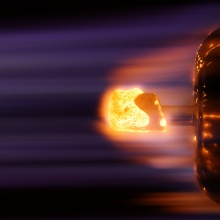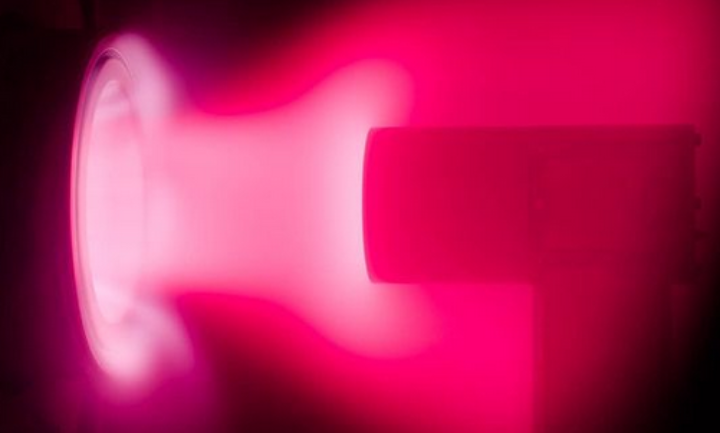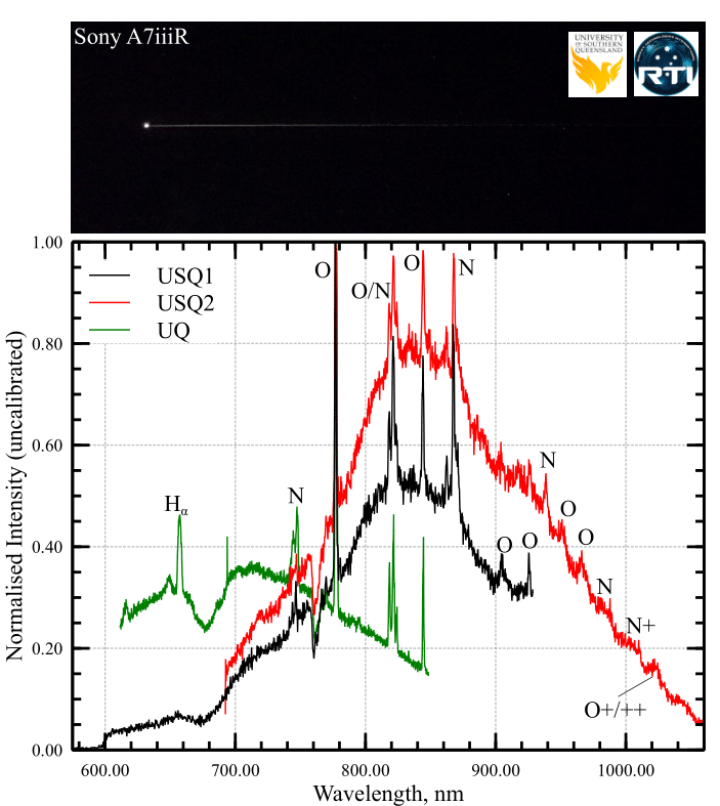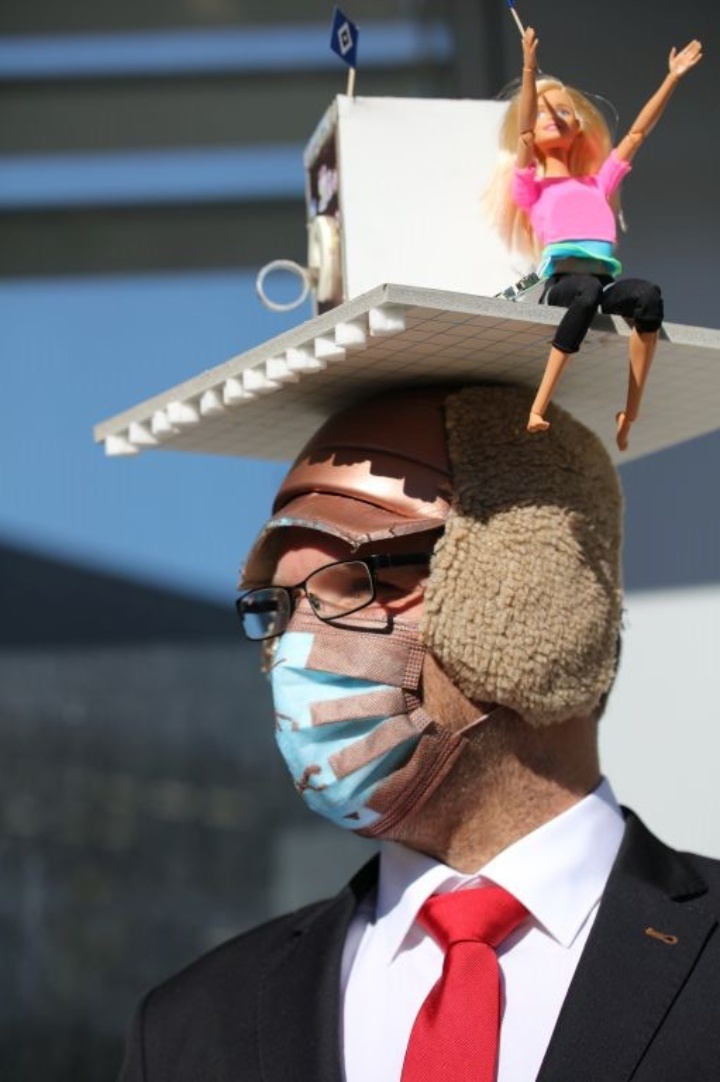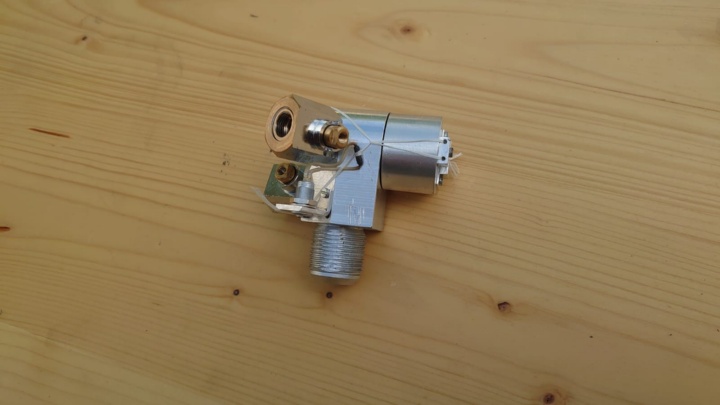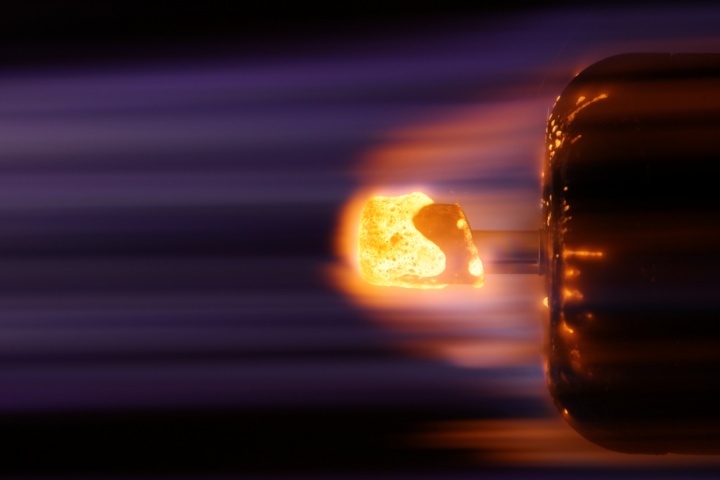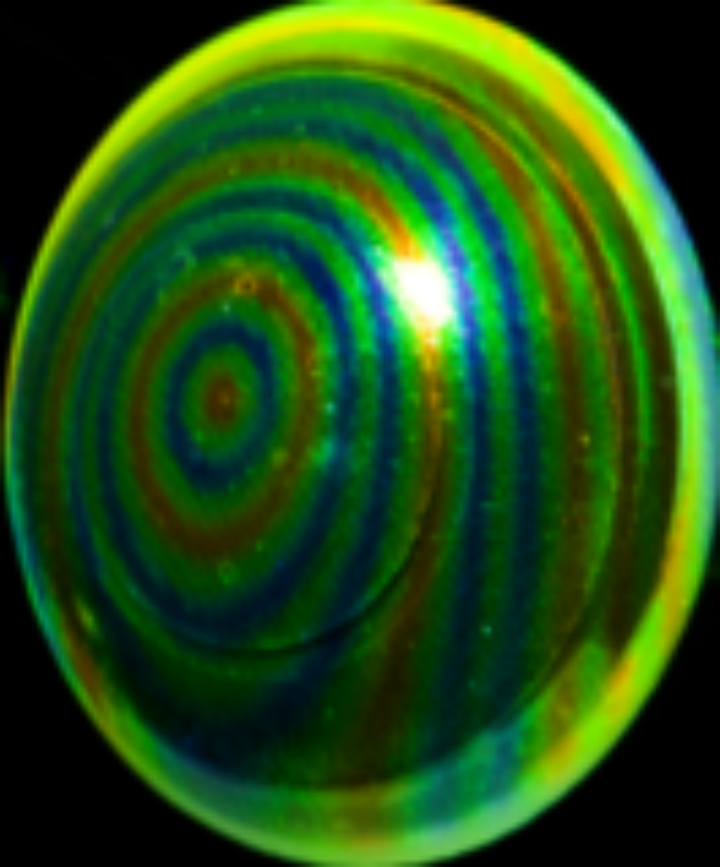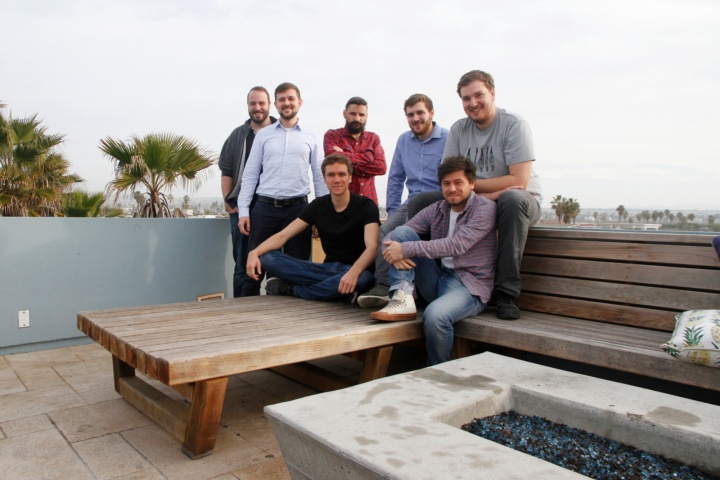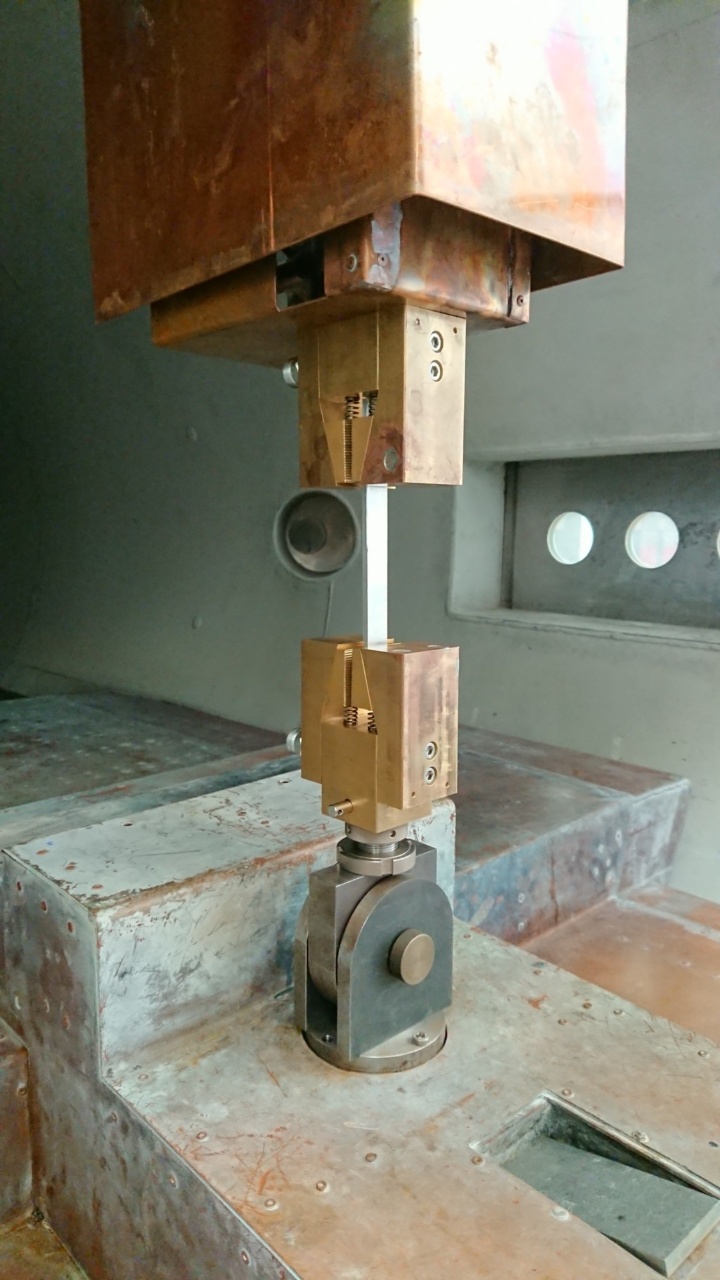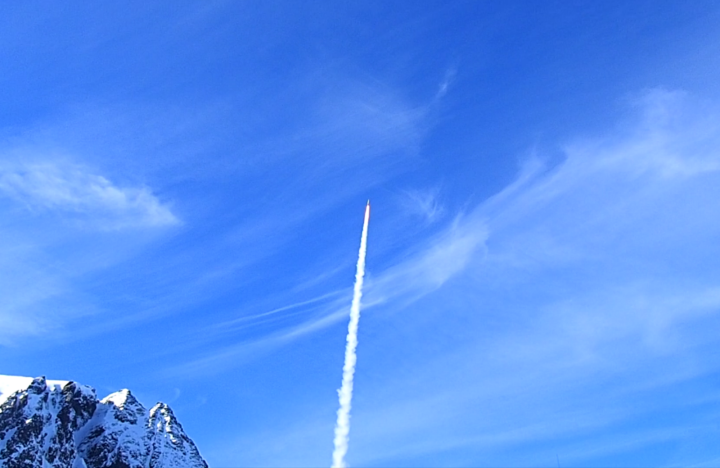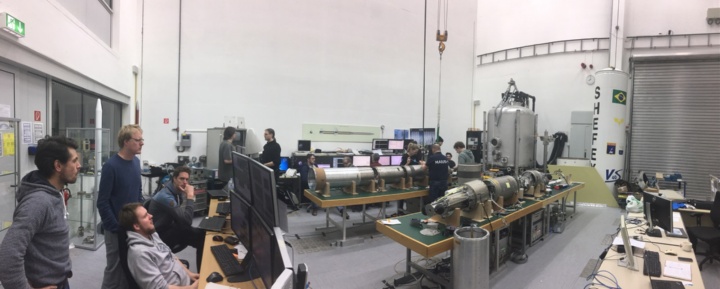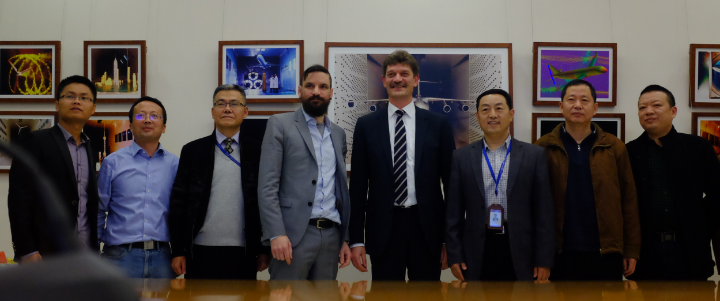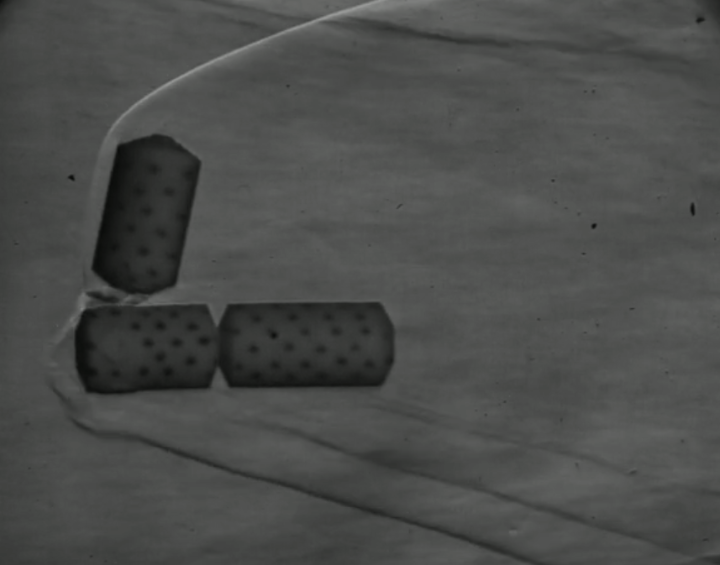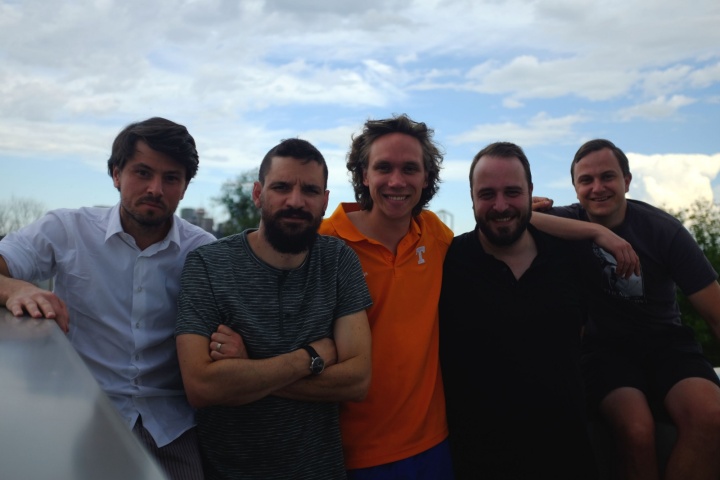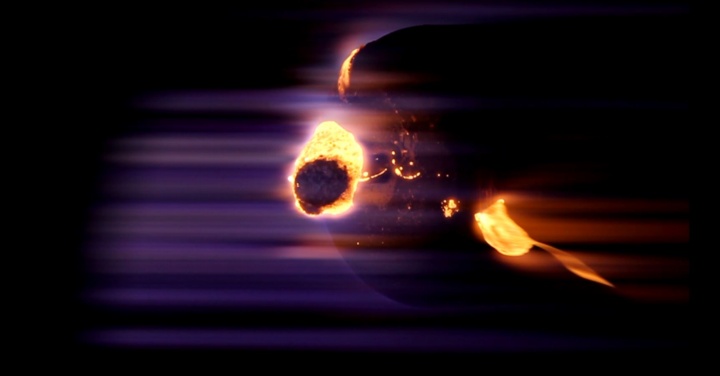Die Arbeitsgruppe HEFDiG nutzt und entwickelt verschiedene Verfahren zur Charakterisierung der Bedingungen, die beim Eintritt von Raumflugkörpern in die Atmosphäre eines Planeten auftreten können. In den Plasmawindkanälen des Instituts werden diese nachgestellt, um bspw. Materialien für die Verwendung in Hitzeschutzsystemen der Flugkörper zu testen. Außerdem sind wir oft bei Beobachtungsmissionen mit eigenen Spektrometern am Start oder versuchen neue Messverfahren an Plasmen zu etablieren.
Mitglieder der Gruppe
Dr.-Ing. Stefan Löhle
Group Leader
Dr.-Ing. Martin Eberhart
Lightfield Imaging for High-Enthalpy Flows
Dr.-Ing. David Leiser
Optical Diagnostics for Non-equilibrium Flows
Dr.-Ing. Fabian Hufgard
Solid Electrolyte Sensor Development for Sounding Rockets and Satellites
M. Sc. Igor Hörner
Solid Electrolyte Sensor Development for Sounding Rockets and Satellites
M. Sc. Christian Dürnhofer
Heat Flux Profile Determination using NISI Method
M. Sc. David Steuer
Ice Giant Entry Experiments
M. Sc. Clemens Müller
Experimental Re-entry Break-up
M. Sc. Dominik Kuenstler
Particle Development from Re-entry Objects
M. Sc. Lasse Voigt
Diagnostic for atomic oxygen in Very Low Earth Orbit (SFB1667 ATLAS, A04)
Ehemalige
Dr.-Ing. Christoph Eichhorn
(Leibniz-Institut für Oberflächenmodifizierung, Leipzig)
Dr.-Ing. Andreas Steinbeck
(Airbus Defense and Space, Lampoldshausen)
Dipl.-Ing. Ulf Fuchs
(Euro Engineering, Friedrichshafen)
Dr.-Ing. Thomas Marynowski
(Tesat Spacecom, Backnang)
Dr.-Ing. Hannes Hoos
(Tesat Spacecom, Backnang)
Dr.-Ing. Tobias Hermann
(Post-Doc, University of Oxford, GB)
Dipl.-Ing. Rainer Öfele
(ElringKlinger AG)
Prof. Fabian Zander
(University of Southern Queensland, Toowomba, Australien)
Dr. Nathan Stern
Dr.-Ing. Arne Meindl
(Max-Planck-Institut für Plasmaphysik, München)
Dr. Ranjith Ravichandran
(Post-Doc Researcher University of Southern Queensland)
Dr. Erik Poloni
(Post-Doc Researcher, Queen Mary College London, GB)
Dr.-Ing. Felix Grigat
(Nordex, Hamburg)
Publikationen (Auszüge)
Hoerner, I.; Stern, N.; Eberhart, M.; Loehle, S.; Fasoulas, S. (2025): Fast response solid electrolyte oxygen sensors with porous thin film electrodes. In: The Review of Scientific Instruments 96 (1). DOI: 10.1063/5.0238213.
Mueller, Clemens; Leiser, David; Loehle, Stefan; Fasoulas, Stefanos (2024): Transient Plasma Wind Tunnel Testing Under Thermomechanical Loads for Reentry Break-Up Analysis. In: AIAA Journal of Spacecraft and Rockets, S. 1-8. DOI: 10.2514/1.A36039.
Eberhart, Martin; Loehle, Stefan; Grigat, Felix; Connolly, Jonathan; McGilvray, Matthew; Gillespie, David R. H. (2024): Transient Three-Dimensional Measurement of Ice Crystal Accretion Using a Plenoptic Camera. In: AIAA Journal, S. 1-12. DOI: 10.2514/1.J064079.
Poloni, Erik; Grigat, Felix; Eberhart, Martin; Leiser, David; Sautière, Quentin; Ravichandran, Ranjith et al. (2023): An open carbon-phenolic ablator for scientific exploration. In: Scientific reports 13 (1), S. 13135. DOI: 10.1038/s41598-023-40351-x.
Hufgard, Fabian; Duernhofer, Christian; Fasoulas, Stefanos; Loehle, Stefan (2023): Novel heat flux controlled surface cooling for hypersonic flight. In: Scientific reports 13 (1), S. 13109. DOI: 10.1038/s41598-023-40281-8.
Grigat, F.; Loehle, S.; Zander, F.; Fasoulas, S. (2022): Spallation on Carbon Ablators. In: AIAA Journal 60 (7), S. 3936–3949. DOI: 10.2514/1.J061276.
Leiser, D.; Loehle, S.; Fasoulas, S. (2022): Spectral Features for Re-entry Break-up Event Identification. In: Journal of Spacecraft and Rockets 59 (5), S. 1496–1506. DOI: 10.2514/1.A35258.
Hufgard, F.; Loehle, S.; McGilvray, M.; Hermann, T.; Schweikert, S.; Wolfersdorf, J. von et al. (2021): Plenum Pressure Behavior in Transiently Heat Loaded Transpiration Cooling System. In: Journal of Thermophysics and Heat Transfer 35 (2), S. 256–267. DOI: 10.2514/1.T6089.
Ravichandran, R.; Leiser, D.; Zander, F.; Loehle, S.; Matlovič, Pavol; Tóth, Juraj; Ferrière, Ludovic (2021): High frame rate emission spectroscopy for ablation tests in plasma wind tunnel. In: The Review of Scientific Instruments 92 (3), S. 33101. DOI: 10.1063/5.0040801.
Eberhart, M.; Loehle, S.; Offenhäuser, P. (2021): 3-D Visualization of Transparent Fluid Flows from Snapshot Light Field Data. In: Experiments in Fluids 62 (8). DOI: 10.1007/s00348-021-03255-y.
Eberhart, M.; Loehle, S.; Oefele, R.; Fasoulas, S. (2020): Transient Response of Amperometric Solid Electrolyte Oxygen Sensors under High Vacuum. In: Sensors and Actuators B: Chemical 323, S. 128639. DOI: 10.1016/j.snb.2020.128639.
Matlovič, P., Tóth, J., Kornoš, L. , Loehle, S., "On the sodium enhancement in spectra of slow meteors and the origin of Na-rich meteoroids", Icarus 347, 2020
Hermann, T., McGilvray, M., Ifti, H. S., Hufgard, F., Loehle, S., "Thermal Impulse Response in Porous Media
for Transpiration-Cooling Systems", Journal of Thermophysics and Heat Transfer, Vol. 34, No. 2, 2020
Eberhart, M., Loehle, S., "Light-Field Imaging for Plasma Wind-Tunnel Application", Journal of Thermophysics and Heat Transfer, Vol. 33, No. 2, 2019
Eberhart, M., Loehle, S., Strelnikov, B., Hedin, J., Khaplanov, M., Fasoulas, S., Gumbel, J., Lübken, F.-J., Rapp, M.," "Atomic oxygen number densities in the mesosphere–lower thermosphere region measured by solid electrolyte sensors on WADIS-2", Atmos. Meas. Tech., 12, 2445–2461, 2019
Meindl, A., S. Loehle S. Fasoulas, "Two-photon induced polarization spectroscopy of xenon
7p[1/2]0", Applied Optics, 57(31):9414–9422, 2018.
Zander, F., Loehle, S., Hermann, T., Fulge, H., "Fabry-Perot Spectroscopy for Kinetic Temperature and Velocity Measurements of a High Enthalpy Air Plasma Flow", Journal of Applied Physics D, Vol. 50, No. 33, 2017
Loehle, S., Zander, F., Hermann, T., Eberhart, M., Meindl, A., Oefele, R., Vaubaillon, J., Colas, F., Vernazza, P., Drouard, A., Gattacceca, J., "Experimental Simulation of Meteorite Ablation during Earth Entry Using a Plasma Wind Tunnel," Astrophysical Journal, 837, 2017
Loehle, S. (2017): Derivation of the Non-Integer System Identification Method for the Adiabatic Boundary Condition Using Laplace Transform. In: International Journal of Heat and Mass Transfer 115, S. 1144–1149. DOI: 10.1016/j.ijheatmasstransfer.2017.08.007.
S. Loehle, T. Hermann, and F. Zander, "Experimental Assessment of the Performance of Ablative Heat Shield Materials from Plasma Wind Tunnel Testing", CEAS Space Journal, 2017
T. Hermann, S. Löhle, F. Zander, H. Fulge, and S. Fasoulas, "Characterization of a Re-entry Plasma Wind Tunnel Flow with Vacuum Ultraviolet to Near Infrared Spectroscopy," Journal of Thermophysics and Heat Transfer, vol. 30, iss. 3, pp. 673–688, 2016
P. Jenniskens, J. Albers, M. Koop, M. Odeh, K. Al-Noimy, K. Al-Remeithi, K. Al Hasmi, R. F. Dantowitz, F. Gasdia, S. Loehle, F. Zander, T. Hermann, D. Farnocchia, S. R. Chesley, P. W. Chodas, R. S. Park, J. D. Giorgini, W. J. Gray, D. K. Robertson, and T. Lips, "Airborne Observations of an Asteroid Entry for High Fidelity Modeling: Space Debris Object WT1190F," in Proc. SciTech 2016, 2016
S. Loehle, S. Fasoulas, G. Herdrich, T. Hermann, B. Massuti-Ballester, A. Meindl, A. S. Pagan, and F. Zander, "The Plasma Wind Tunnels at the Institute of Space Systems: Current Status and Challenges," in Proc. 46th Aerodynamic Measurement Technology and Ground Testing Conference, 2016
S. Loehle, T. Hermann, and F. Zander, "Experimental Assessment of the Performance of Ablative Heat Shield Materials from Plasma Wind Tunnel Testing," in Proc. 8th ESA Workshop on Thermal Protection Systems and Hot Structures, 2016,
F. Zander, T. Hermann, and S. Loehle, "Plasma Wind Tunnel Flow Analysis with High Speed Imaging," in Proc. 46th AIAA Thermophysics Conference, 2016,
F. Zander and S. Loehle, "Analysis of Air Plasma Flows in Magnetoplasmadynamic Arcjet Testing," in Proc. 46th AIAA Thermophysics Conference, Washington, DC, 2016,
2025
Mai
HEFDiG participates at ESA's FAR Conference in Arcachon France with a nice suite of contributions around Ice Giant simulation, new heat flux gages, spectrographic marker testing, fabry-perot interferometry, event-based camera imaging and re-entry break-up experiments
April
HEFDiG participates with two contributions to the European Space Debris Conference in Bonn. We present two papers around the airborne re-entry observations we conducted in 2024: the Cygnus NG20 entry and the Cluster-II Salsa re-entry observation mission.
We welcome Lasse Voigt, new PhD student in the group, who starts analysing atomic oxygen diagnostics for VLEO environments
We welcome Benjamin Rusche, who starts as a new technician in the wind tunnel laboratory. A dream came true!
März
The last weeks of testing before we will get a major refurbishment of the vacuum system. We have a 10weeks downtime, but are then allowed to run 2g/s H2 through the pumps and will be able to do transient testing in our plasma wind tunnels (see Paper of Clemens Müller).
Februar
Crazy times. We will prepare a set of HARLEM heat shields for a future flight with the University of Kentucky capsules. We are extremely thankful to Prof. Alexandre Martin who provided an opportunity to develop a flight hardware.
Januar
Happy New Year to the World!
2024
November 2024
Congratulations!!! Fabi and Felix successfully defended their dissertations. Great Job!
October 2024
Stefan is participating at the ESA Clean Space Days at ESTEC. There is also the final presentation of the ESA project on Thermomechanical Break-up and we are invited to give a keynote at the workshop around the Cluster-II Salsa observation mission.
September 2024
Clemens and Stefan participated in the airborne observation of Cluster-II Salsa. We were the science coordinator of this mission, again designed and organised by Prof. Fabian Zander from University of Southern Queensland. The whole mission is an ESA project led by Astros Solutions from Bratislava in Slovakia. We have deployed 26lenses aboard a Falcon 900. The trip was a crazy experience flying from Stuttgart to Sydney, to Auckland, to Tahiti, to Easter Island and back.
August 2024
AIAA Aviation in Texas. HEFDiG was represented by Clemens and David Steuer, presenting papers about re-entry break-up experiments and future flights to Uranus or Neptune.
July 2024
We participated in the airborne observation of CYGNUS-NG20 in the Southern Pacific. David Leiser was onboard and found the capsule up in the sky with our brandnew Nikon Z8 with HEFDiG spectrometer extension. Prof. Alex Martin of University of Kentucky in Lexington was the PI for the mission. The mission itself was designed and organised by Prof. Fabian Zander of University of Southern Queensland (former Post-Doc in HEFDiG!). It was a spectacular to be part of this exciting mission!
June 2024
Clemens' paper on transient plasma wind tunnel testing is published:
Mueller, Clemens; Leiser, David; Loehle, Stefan; Fasoulas, Stefanos (2024): Transient Plasma Wind Tunnel Testing Under Thermomechanical Loads for Reentry Break-Up Analysis. In: AIAA Journal of Spacecraft and Rockets, S. 1–8. DOI: 10.2514/1.A36039.
May 2024
Christian and Stefan gave talks at the Korea Advanced Institute of Science and Technology (KAIST) workshop on ceramic matrix composites. Prof. Gisu Park invited us. Great talks, excellent food, very inspiring country!
April 2024
HEFDiG simulated the entry of the ISS battery pack. Simulation and real entry flight compare exceptionally well.
März 2024
The video of a demising reaction wheel in the PWK4 at IRS in comparison to the simulation by HTG became a highlight video of the Mechanisms Workshop at ESA/ESTEC.
Welcome Dominik Kuenstler! Dominik starts his PhD funded through the Boysen Foundation, we are investigating what actually happens to all the spacecraft which 'demise'. Eventually, a bunch of small solid particles is expected, but how do these develop?
Februar 2024
Expirements in PWK4 show that thermite additives can change the break-up and melting of structures. HEFDiG studied this within the D4D-ER project funded through ESA and primed by OHB. The thermite samples were provided by T-Engineering. Calculations are performed by Belstead.
Januar 2024
Stefan is awarded AIAA Associate Fellow at the 2024 Scitech Conference in Orlando, FL.
Stefan spent a great week at the University of Kentucky in Lexington with Prof. Alexandre Martin. We conducted some nice experiments at his beautiful HELMUT facility.
2023
Dezember 2023
PhD Defense of David Leiser. Great work, great job, excellent drinks in a fancy bar downtown. Congratulations!
November 2023
Successfully delivered new slug calorimeters to TEKNA Plasma Systems.
Oktober 2023
A new project for the development of Hydrogen sensors based on the electrochemical sensors we already have (FIPEX) starts. Funded by the Vector foundation with a high risk high gain approach, the project might deliver new sensors. HYPE, the project name already fits well.
September 2023
What a trip. HEFDiG particpated (as the only Europeans!) in the airborne and ground based observation of the OSIRIS-REx entry flight. The campaign called HORIS consisted in four(!) aircraft. One of the aircraft was led by former HEFDiG-member Fabs Zander from UniSQ. HEFDiG deployed an Echelle spectrometer aboard a NASA research aircraft. Together with NASA and UniSQ, two ground based systems were deployed in the desert in Utah.
The fantastic news is also: WE GOT DATA!
August 2023
August is vacation time. However, some of HEFDiG's crew is at work, taking the occasion to take a coffee without conversation at the famous table.
Juli 2023
HEFDiG delivers fully calibrated FIPEX sensors and electronics to University of Colorado in Boulder, CO. The sensors will be deployed in the SWARM-EX satellite mission.
Juni 2023
A workshop on positive leadership by Jan Nicoleit gives a lot of motivation to HEFDiG for better performance through even more positive mindset.
Three test campaigns in three weeks: ESA - TMFM, ESA - Demisable Reaction Wheel, Heat Flux Gages for KAIST.
Mai 2023
Emission spectroscopic measurements of the exhaust plume of a CH4-LOX combustion at the P8 rocket test rig in Lampodshausen with DLR Lampoldshausen.
April 2023
The special issue in ICARUS with ~8articles originating from the meteorite testing is about to be completed. Two papers missing.
März 2023
HEFDiG will participate in the airborne observation campaign of OSIRIS-REx entry. This is fantastic!
Februar 2023
Kick-off of the ESA Ice Giant Sensors Project. Within a one year project, the entry into the atmosphere of Uranus and/or Neptune is going to be studied by FGE, Space Ballistics, University of Oxford and HEFDiG in order to suggest and test a first breadboard of a sensor suite to investigate the entry and/or the atmosphere.
Januar 2023
HEFDiG contributes to the 2023 AIAA Scitech in National Harbour, MD with XX papers:
- Duernhofer, Christian; Meindl, Arne; Eberhart, Martin F.; Loehle, S. (2023): Assessment of Arcjet Radiation by Mass Addition. In: SciTech 2023 Forum. AIAA SCITECH 2023 Forum. National Harbor, MD & Online. AIAA. Reston, VA, USA: American Institute of Aeronautics and Astronautics.
- Leiser, David; Dürnhofer, Christian A.; Loehle, S.; Vaubaillan, J.; Fasoulas, Stefanos (2023): Luminous Efficiency Determination of Spacecraft Materials in Ground Test Facilities. In: SciTech 2023 Forum. AIAA SCITECH 2023 Forum. National Harbor, MD & Online. AIAA. Reston, VA, USA: American Institute of Aeronautics and Astronautics.
- Steuer, David C.; Hambidge, Christopher; McGilvray, Matthew; Loehle, S. (2023): A Method for Direct Shear Measurement of Large Scale Roughened Surfaces in Hypersonic Flow. In: SciTech 2023 Forum. AIAA SCITECH 2023 Forum. National Harbor, MD & Online. AIAA. Reston, VA, USA: American Institute of Aeronautics and Astronautics.
- Eberhart, M.; Loehle, S.; Grigat, F.; Connolly, J.; McGilvray, M.; Gillespie, D. (2023): 3D Measurement of Ice Crystal Accretion using a Plenoptic Camera. In: SciTech 2023 Forum. AIAA SCITECH 2023 Forum. National Harbor, MD & Online. AIAA. Reston, VA, USA: American Institute of Aeronautics and Astronautics
2022
Dezember 2022
During a 1day workshop with all group members we try to find out what an inverse problem actually means. Very exciting! The day finds a beautiful end with our legendary Weihnachtsfeier - meanwhile we need two tables to host all former and actual members of the group. Crazy!
November
Clemens Mueller starts with HEFDiG. His PhD topic is re-entry break-up diagnostics. Stefan participates in the data analysis workshop from the tau-Herculids observation at the Observatoire de Paris. We welcome guests from Australia, Prof. Zander and Prof. Buttsworth, for a couple of days around our old coffee table.
Oktober
David Steuer joins HEFDiG. His PhD topic is around the spectroscopic analysis of entries into the atmoshpheres of Uranus or Neptune.
September
HEFDiG participates in ESA's Radiation of High Temperature Gases Workshop on the Azores.
Juli
Successful finalization of the ESA project on IceGiant entry analysis together with the University of Oxford. Stefan participates in the 2022 Aviation conference in Chicago, IL.
Juni
HEFDiG participates with a lot of presentations at the FAR conference in Heilbronn.
Mai
On the 31st of May, HEFDiG takes spectra of the tau-Herculids meteor shower. Beautiful shooting stars above the clouds of Texas. The mission is funded by Rocket Technology International (RTI) and organized by the University of Southern Queensland (Prof. Fabian Zander). Participants are: Juraj Toth (Comenius University of Bratislava, Slovakia), Jeremie Vaubaillon (Astronomer, Observatoire de Paris) and Stefan (HEFDiG)
April
We welcome Quentin Sautiere from CentraleSupelec in Paris for an intern. He is going to support the heat flux measurement research.
März
Third MetSpec Campaign in the plasma wind tunnels. So many shooting stars! Fantastic. For the very first time, we realize a live view of the experiments over webex.
Februar
Experiments, and experiments, and experiments...
Januar
Sara Delahaie joins for an internship from CentraleSupelec. She is going to work on optical emission spectroscopy and supports Ranjith's work.
2021
Stefan is for one month in Paris as a guest researcher invited by the Paris Observatory (namely Jeremie Vaubaillon).
Felix and Martin are in Ontario, Canada with the plenoptic equipment. They try to measure ice layers on turbine blades in a large icing wind tunnel. The work is in cooperation with Prof. Matt McGilvray from the University of Oxford
We have the go to perform the second series of meteorite sample testing. The colleagues from the Comenius University in Bratislava, Slovakia join us.
Martin is invited to give a talk at the Bold Research meeting at the University of Stuttgart with his new ideas on testing of ancient gas compositions, i.e. 2.5billion years ago.
Erik Poloni joins us as a Post-Doc. He brings is expertise in materials and we plan to develop with him our own carbon-phenolic lightweight ablator for in-depth diagnostics and Ice Giant work
We have successfully tested the high heat flux condition within the MACH project: 15MW/m² on a 1" coupon at 27hPa total pressure.
- Martin publishes the first 2021 journal article in AIAA Journal of Thermophysics and Heat Transfer. Well done!
- Our former colleague Fabian 'Fabs' Zander realized an airborne observation campaign of the Hayabusa 2 re-entry. Attached a first look of some of the excellent data they recorded on a clear night sky on Dec 5, 2020. After his years with HEFDiG, Fabs became Professor at the University of Southern Queensland, where he continues in the fine sense of HEFDiG, to develop diagnostics for the various hypersonics problems. Congratulations Fabs!
2020
Stefan is awarded a 2months research stay in 2021 at the renowned Observatoire de Paris
Bad news: The rocket campaign PMWE (3+4) is cancelled for this year. The rocket and the FIPEX sensors are ready, but the COVID-19 rules do not allow the mission to happen. Too many quarantines. The new sensor enclosure will have to wait. Next idea is early 2021
Paper Accepted! Paper on Lightfield Imaging is accepted in Journal of Thermophysics and Heat Transfer: 3-D Analysis of transparent Flames by Light Field Deconvolution. Martin: Congratulations!
New Project! We are going to investigate Ice Giant entries using the plasma wind tunnel facilities with our diagnostics. The project is supported through an ESA project.
Dr. Löhle is promoted to Akademischer Oberrat (maybe a senior research scientist... well, similar, but different).
New Publication in Sensors and Actuators: B. Chemical: M.Eberhart, S. Löhle, R. Öfele, S. Fasoulas, Transient Response of Amperometric Solid Electrolyte Oxygen Sensors under High Vacuum, doi:10.1016/j.snb.2020.128639
First Meteorite Campaign in the METSPEC project with the University of Bratislava. Sensational data sets including Chelyabinsk samples.
Arne has managed to detect O2 polarization spectra in the resonator section of a microwave-powered plasma torch operating at atmospheric pressure. This is the first time this technique has been successfully applied to O2 detection. In order to verify the results, Arne has developed a new code for simulation of polarization spectra of O2 Schumann-Runge absorption.
David Leiser successfully experiments with mechanical loads for the assessment of spacecraft fragmentation.
Dr. Nathan Stern joins HEFDiG. He is going to investigate the possiblity to measure CO2 with a FIPEX sensor. The project is funded by the Boysen foundation.
Christian Duernhofer joins HEFDiG. He is going to bring in new ideas in the measurement of heat flux distributions within the MACH project.
Dr. Ranjith Ravichandran joins HEFDiG. He is going to work on meteoroid entries and our origin of life project named URSUPPE.
HEFDiG becomes partner in the project MACH. We investigate transpiration cooled leading edges in a grant funded by the U.S. Darpa. The partners are: University of Oxford (Prime), Fluid Gravity Engineering, University of Queensland, Imperial College London.
2019
HEFDiG receives a RiSC grant which allows the investigation of the very early Earth times. In the project URSUPPE we try to simulate and investigate entries of extraterrestrial material in the context of bringing life to planet Earth.
Martin found new results with the lightfield camera. The following video shows the 3D distribution of light points in space found from one single exposure of the camera and the new lightfield reconstruction algorithm.
Wir freuen uns sehr! Prof. Matt McGilvray (Universtiy of Oxford) verbringt drei Forschungsmonate in unserer Gruppe. Die wesentlichen Themen sind Transpirationskühlung, Laserdiagnostik und Analyse von Hochgeschwindigkeitsaufnahmen in den Plasmaströmungen. WILLKOMMEN!
Stefan war zur Meteoroids eingeladen, um einen Plenarvortrag zu den Experimenten mit Meteoritenbruchstücken (siehe weiter unten) zu halten.
https://fmph.uniba.sk/en/microsites/daa/division-of-astronomy-and-astrophysics/meteoroids-2019/
Es wurden folgende Beiträge vorgestellt:
S. Loehle, F. Hufgard, H. Boehrk, C. Dittert, "Measurement of Surface Heat Flux Distribution on a Transpiration Cooled Wedge in a Supersonic High-Enthalpy Air Flow", AIAA Scitech 2019 Forum, San Diego, California, 2019, AIAA-2019-1557.
M. Eberhart, S. Loehle, "Light Field Analysis of optically thin Plasma Flows", AIAA Scitech 2019 Forum, San Diego, California, 2019, AIAA-2019-1503.
D. Leiser, S. Loehle, F. Zander, R. Choudhury, D. Buttsworth, S. Fasoulas, "Spacecraft Material Tests under Aerothermal and Mechanical Reentry Loads", AIAA Scitech 2019 Forum, San Diego, California, 2019, AIAA-2019-0161.
F. Hufgard, S. Loehle, J. von Wolfersdorf, S. Fasoulas, M. Ewenz Rocher, T. Hermann, M. McGilvray, J. Steelant, "Surface Heat Flux Measurement in Transpiration-Cooled Porous Materials using Plenum Pressure Data", AIAA Scitech 2019 Forum, San Diego, California, 2019, AIAA-2019-2062.
I. Hörner, R. Öfele, M. Eberhart, S. Loehle, S. Fasoulas, "Concept of Solid Electrolyte Sensors for Atomic Oxygen Detection in High-Enthalpy Flows", AIAA Scitech 2019 Forum, San Diego, California, 2019, AIAA-2019-1937.
A. Meindl, S. Loehle, I. Kistner, A. Schulz, S. Fasoulas, "Two-Photon Induced Polarization Spectroscopy for Atomic Oxygen in Atmospheric Plasma and Xenon", AIAA Scitech 2019 Forum, San Diego, California, 2019, AIAA-2019-1506.
2018
Stefan ist beim Workshop on Space Situational Awarness am Korean Advanced Institute of Technology (KAIST) in Daejeon eingeladen über die Experimente zum Re-entry break-up vorzutragen. Ein Mega-Trip!
Martin Eberhart wird mit seiner Arbeit "Festelektrolytsensoren zur Messung von atomarem Sauerstoff auf Forschungsraketen" zum Dr.-Ing. promoviert. Herzlichen Glückwunsch.
HEFDiG goes Australia! Martin Eberhart und Stefan Löhle sind im Rahmen eines DAAD-Austauschprogramms an der University of Southern Queensland in Toowoomba, um Untersuchungen zum Re-entry break-up durchzuführen. Dazu wurden Aufnahmen mit der plenoptischen Kamera durchgeführt. Auch wenn die Ergebnisse noch nicht klar sind, die Bilder sind grandiose pop-art!
Felix Grigat startet seine Doktorarbeit. Herzlich Willkommen! Er wird sich mit der photogrammetrischen Erfassung von Oberflächenphänomenen beim Eintritt in Planetenatmosphären beschäftigen.
Erfolg! Wir haben den weltweit ersten Zugversuch unter Wiedereintrittsbedingungen mit Davids neuem Aufbau durchgeführt!
Igor Hörner hat seine Doktorarbeit begonnen. Herzlich Willkommen!
Stefan wurde für die kommenden drei Jahre ins Technical Committee für Plasmadynamics and Lasers der AIAA gewählt.
Nach schier unendlicher Detailarbeit ist Arne Meindl gelungen, two-photon induced polarization spectroscopy (TIPS) an Xenon zu realisieren. Wir erhoffen uns hiervon quantitative Messungen von atomarem Sauerstoff auch bei höheren Drücken, bei welchen laserinduzierte Fluoreszenzmessungen schwieriger werden.
2017
Es gibt neue Analysen der Meteoritenversuche. Hier ein Video mit automatischer shape detection.
Tobias Hermann wurde mit der Arbeit "Emissionsspektroskopische Analyse einer hyperbolischen Wiedereintrittsströmung im Plasmawindkanal zum Dr.-Ing. promoviert. Wir gratulieren!
S. Löhle macht einen Ausflug an die University of Oxford und besucht Prof. Matt McGilvray am Osney Lab. Dort gibt es jetzt sehr spannende Anlagen. Im Rahmen der Partnerschaft in einem großen EPSRC grant diskutieren wir diverse Möglichkeiten zur Transpirationskühlung.
Wir dürfen am legendären Plasmawindkanal der NASA in Kalifornien mit unserem FIPS System an den Start. Es gibt eine Messkampagne mit simultanen Messungen von Fabry-Perot-Interferometrie und laser-induzierter Fluoreszenz. Sehr spannend! Und irgendwie müssen 130kg Hardware nach San Francisco.
Schöne Paper, interessante Konferenz, tolle Dachterrasse!
Es wurden folgende Beiträge vorgestellt:
M. Eberhart, S. Loehle, "Lightfield Imaging for Plasma Wind Tunnel Application" in Proc. 33rd AIAA Aerodynamic Measurement Technology and Ground Testing Conference, Denver, CA, 2016, AIAA 2017-4066
A. Meindl, D. Leiser, S. Loehle, S. Fasoulas, "Two-Photon Induced Polarization Spectroscopy with Atomic Oxygen and Xenon for Plasma Diagnostics" in Proc. 48th AIAA Plasma Dynamics and Laser Conference, Denver, CA, 2016,
AIAA 2017-4157
Zander, F., S. Loehle, "Air Plasma Flow Analysis for Parameterised Magnetoplasmadynamic Arcjet Operation" in Proc. 33rd AIAA Aerodynamic Measurement Technology and Ground Testing Conference, Denver, CA, 2016, AIAA 2017-4522
S. Loehle, F. Zander, T. Hermann, M. Eberhart, A. Meindl, R. Oefele, J. Vaubaillon, F. Colas, P. Vernazza, A. Drouard, J. Gattacceca, "Aerothermal Testing of Meteorite Fragments" in Proc. 47th AIAA Thermophysics Conference, Denver, CA, 2016, AIAA 2017-4453
David Leiser fängt in der Gruppe an. Er wird sich mit dem Aufbrechen großer Strukturen beim Wiedereintritt beschäftigen. Das DLR hat uns hierfür ein großes Projekt in Kooperation mit der Hyperscchalltechnologie Göttingen genehmigt. Herzlich Willkommen!
Wir begrüßen Fabian Hufgard! Er beginnt eine Doktorarbeit zu neuartigen Wärmestromdichtesensoren. Viel Erfolg!
Martin Eberhart hat im Rahmen einer Post-Doc Position mit der Erforschung der Lichtfeldphotographie zur Diagnose hochenthalper Strömungen begonnen. Wir wünschen viel Erfolg bei diesem spannenden Thema!
Welcome back!
2016
7th International Workshop on Radiation of High Temperature Gases
Unsere Arbeitsgruppe richtete den RHTG Workshop 2016 aus. Wir bedanken uns bei allen Teilnehmern für eine interessante und spannende Woche!
Dr.-Ing. Thomas Marynowski
Unser ehemaliger Kollege Thomas Marynowski wurde zum Dr.-Ing. promoviert. Wir jubeln und gratulieren!
Tomographische Spektroskopiemessungen erlauben eine dreidimensionale Rekonstruktion von einem Luftplasma im Plasmawindkanal PWK1.
Bild: Oberflächen gleicher Gesamtstrahlungsintensität des Plasmafreistrahls gemessen in diskreten Abständen vom Generatorausgang mit Belichtungszeiten (a) 0.25 ms, (b) 0.8 ms, (c) 1.6 ms, (d) 10 ms.
Diese und mehr spannende Erkenntnisse aus den tomographischen Messungen werden veröffentlicht in:
T. Hermann, S. Loehle, S. Fasoulas, and A. Adrianatos, "Tomographic Optical Emission Spectroscopy for Plasma Wind Tunnel Testing," Applied Optics, 2016, under review
Erstmalige Untersuchungen von Meteoritenbruchstücken im Plasmawindkanal
Wir haben ein Meteoritenbruchstück beim Eintritt in die Erdatmosphäre experimentell nachgestellt. Das Steinchen wurde uns vom Observatoire de Paris und dem Laboratoire d'Astrophysique de Marseille zur Verfügung gestellt.
Neben High-Speed-Videos, thermographischen Aufnahmen, wunderbaren Fotos und hochaufgelösten optischen Spektren, ist auch ein schlichtes Video dabei rausgekommen.
Sieht das nicht fantastisch aus?
Beobachtung des Wiedereintritts von CYGNUS OA6
F. Zander und T. Hermann waren an Bord eines business jets zur Beobachtung des Eintritts von CYGNUS OA6.
Siehe auch hier:
Teilnahme an der AIAA Aviation Conference 2016 in Washington, D.C.
Es wurden folgende Beiträge vorgestellt:
M. Eberhart, S. Loehle, F. Zander, H. Merbold, A. Murk, and S. Merli, "Electromagnetic Wave Transmission through Lightweight Carbon Phenolic Ablator: Microwave to Infrared Frequencies," in Proc. 32nd AIAA Aerodynamic Measurement Technology and Ground Testing Conference, Washington, DC, 2016,
T. Hermann, S. Loehle, R. Öfele, S. Fasoulas, and A. Adrianatos, "Tomographic Optical Emission Spectroscopy for Plasma Wind Tunnel Testing," in Proc. 46th AIAA Thermophysics Conference, Washington, DC, 2016,
S. Loehle, "Review of Heat Flux Measurements for High Enthalpy Flows," in Proc. 32nd AIAA Aerodynamic Measurement Technology and Ground Testing Conference, Washington, DC, 2016,
S. Loehle, A. Nawaz, G. Herdrich, and S. Fasoulas, "Comparisson of Heat Flux Gages for High Enthalpy Flows - NASA Ames and IRS," in Proc. 32nd AIAA Aerodynamic Measurement Technology and Ground Testing Conference, Washington, DC, 2016,
S. Loehle, T. Hermann, F. Zander, and T. Marynowski, "Echelle Spectroscopy for High Enthalpy Flow Diagnostics," in Proc. 32nd AIAA Aerodynamic Measurement Technology and Ground Testing Conference, Washington, DC, 2016,
S. Loehle, S. Fasoulas, G. Herdrich, T. Hermann, B. Massuti-Ballester, A. Meindl, A.S. Pagan, and F. Zander, "The Plasma Wind Tunnels at the Institute of Space Systems: Current Status and Challenges," in Proc. 32nd AIAA Aerodynamic Measurement Technology and Ground Testing Conference, Washington, DC, 2016,
A. Meindl, T. Hermann, S. Loehle, and S. Fasoulas, "Assessment of Coherent Laser Diagnostic Techniques for Probing Atomic Oxygen in High-Enthalpy Flows," in Proc. 47th AIAA Plasmadynamics and Lasers Conference, Washington, DC, 2016,
F. Zander, T. Hermann, and S. Loehle, "Plasma Wind Tunnel Flow Analysis with High Speed Imaging," in Proc. 46th AIAA Thermophysics Conference, Washington, DC,2016,
F. Zander and S. Loehle, "Analysis of Air Plasma Flows in Magnetoplasmadynamic Arcjet Testing," in Proc. 46th AIAA Thermophysics Conference, Washington, DC, 2016,
Die Artikel sind auf Anfrage erhältlich.
2015
Beobachtung des Wiedereintritts von Objekt WT1190F
Mit einer Vorwarnzeit von nur 6 Wochen gelang es eine internationale Beobachtungsmission zu organisieren und durchzuführen. Die Leitung des Unterfangens hatte P. Jenniskens (SETI Institute) und M. Odeh (International Astronomical Center von Abu Dhabi)
An Bord einer Gulfstream 450 montierten wir unser kleines Echelle Spektrometer, um von den prognostizierten 8 Sekunden Beobachtungszeit auch ein paar mitnehmen zu können.
Unser Pointing war nicht optimal und die Tatsache, dass wir noch nie einen Tageintritt beobachtet haben, hat die ganze Arbeit erschwert. Dennoch haben wir das Objekt kurz in unseren Kameras fangen können.
Es war ein fantastischer Trip mit arabischer Welt, amerikanischer Dekadenz und internationaler Wissenschaft!
Siehe auch hier:
http://blogs.esa.int/rocketscience/2015/10/30/esa-sponsors-wt1190f-observations/
http://www.nature.com/news/researchers-rendezvous-with-falling-space-debris-1.18791
Start von O-States 2
Nach einer Schlechtwetterphase, fand am 19.10.2015 um 16:10 lokaler Zeit der zweite Start im Rahmen de O-States Projekts in Kiruna in Nordschweden statt. An Bord waren neue, selbstgefertigte Sauerstoffsensoren. Und es gibt tolle Signale (s.u.)!
Mehr Infos: eberhart@irs.uni-stuttgart.de
Start von O-States 1
Am 2.10.2015 um 7:39 lokaler Zeit startet eine Höhenforschungsrakete im Rahmen de O-States Projekts in Kiruna in Nordschweden. An Bord waren für diesen ersten Start atomare Sauerstoffsensoren wie sie auch bei WADIS geflogen sind. Wir sind gespannt, wie sich die Sensoren bei der bis auf 250km Höhe geflogenen Rakete verhalten. Ein weiterer Start ist für Mitte Oktober geplant. Dann werden neue, tintenstrahlgedruckte Sensoren mitfliegen - Weltpremiere!
Mehr Infos: eberhart@irs.uni-stuttgart.de
Start von WADIS-2
Am 5. März um 2:44 Uhr lokaler Zeit ist am Andoya Space Center im Norden Norwegens die Forschungsrakete WADIS-2 gestartet. Es ist der zweite Start der Mission, die das Ziel hat, Wellenausbreitung und Dissipation in der mittleren Atmosphäre zu untersuchen. Es geht dabei um die Frage, welchen Anteil unterschiedliche physikalische Prozesse am Energiebudget der Erdatmosphäre im Höhenbereich von 70-100km haben. Das Institut für Atmosphärenphysik (IAP) in Kühlungborn hat dazu eine Nutzlast mit verschiedenen Experimenten zusammengestellt, zu der als Hauptinstrumente PHLUX und FIPEX gehören, die in der Arbeitsgruppe Diagnostik hochenthalper Strömungen entwickelt wurden. Beide Instrumente messen die Konzentrationen von atomarem Sauerstoff, in dem Sonnenenergie chemisch gespeichert und transportiert wird. PHLUX misst dazu die Temperaturdifferenz zwischen zwei Materialien, auf deren Oberfläche die Rekombination zu molekularem Sauerstoff in unterschiedlichem Maß abläuft. FIPEX verwendet Festköperelektrolytsensoren mit speziell vergoldeten Elektroden. Beide Systeme wurden im Labor kalibriert.
Die Rakete erreichte ein Apogäum von 126 km und wurde nach dem Flug aus dem Meer geborgen. Alle Instrumente, sowohl an Bord als auch am Boden, funktionierten wie geplant und sendeten direkt Daten an die Telemetriestation. Nach einer ersten Auswertung sind die Ergebnisse von PHLUX und FIPEX sehr vielversprechend, so dass sich, nach Anwendung der Kalibrierdaten, Höhenprofile der Teilchendichte von atomarem Sauerstoff errechnen lassen. Das Flugexperiment wurde vor Ort von Martin Eberhart und Arne Meindl durchgeführt.
Mehr Informationen: eberhart@irs.uni-stuttgart.de
2014
Stefan Löhle erhält den Auftrag mit seinem Team die ESA-Aktivitäten der NASA/ESA-Initiative zur Beobachtung des letzten europäischen Versorgungsraumschiffs ATV-5 zur Internationalen Raumstation ISS zu koordinieren. Der atmosphärische Eintritt von ATV-5 "Georges Lemaitre" wird Ende Februar 2015 über dem Südpazifik stattfinden. Das Raumschiff verglüht beim Eintritt. Die Beobachtung erfolgt vom Flugzeug aus, wobei insgesamt 18 Experimente vorgesehen sind.
Latest news hierzu: http://atv5.seti.org oder loehle@irs.uni-stuttgart.de
Arne Meindl hat seine Doktorarbeit begonnen. Herzlich Willkommen!
Hannes Fulge arbeitet für 4 Wochen im Rahmen eines DAAD-Austauschprogramms an der
University of Queensland am Centre for Hypersonic.
Erkenntnisreiche Teilnahme an der AIAA Aviation Conference 2014
in Atlanta, 16.-20.6.2014
Auf der AIAA Aviation wurden fünf Beiträge vorgestellt:
Fulge, H., Löhle, S., Fasoulas, S., Analysis of Wavelength Modulation Spectroscopy for
Water Vapour Measurements in Supersonic Combustion
Hermann, T., Zander, F., Fulge, H., Löhle, S., Fasoulas, S., Experimental Setup forVacuumUltraviolet
Spectroscopy for Earth Re-entry Testing
Marynowski, T., Löhle, S., Zander, F., Meindl, A., Fasoulas, S., Aerothermodynamic Investigation of Inductively
Heated CO2 Plasma Flows for Mars Entry Testing
Löhle, S., Stäbler, T., Reimer, T., Cefalu, A., Photogrammetric Surface Analysis of Ablation
Processes in High Enthalpy Air Plasma Flow
Löhle, S., Hermann, T., Zander, F., Fulge, H., Marynowksi, T., Ablation Radiation Coupling Investigation in Earth
Re-entry Using Plasma Wind Tunnel Experiments
Die Artikel sind auf Anfrage erhältlich.


